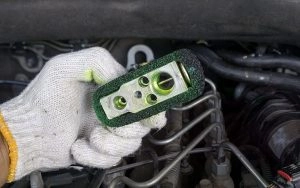In the hot summer, the air conditioner is the optimal solution to alleviate the scorching heat. However, if you notice that your air conditioner is not functioning properly, there could be a problem with the refrigerator valve. Therefore, we will discuss 4 symptoms indicating damage to the air conditioner's refrigerator valve.

The function of the air conditioner's refrigerant valve.
The refrigerator valve is used in the car air conditioner to control the flow of the refrigerant (Freon) to the evaporator. The valve consists of a small valve that opens and closes automatically, and contains a metallic substance that expands and contracts repeatedly as the temperature changes. The valve is installed in the refrigerant line after the condenser and before the evaporator.
When the car's air conditioner is activated, the refrigerant flows from the hot condenser to the cold air conditioner's expansion valve and passes through the extended metallic substance in the valve.
The metallic substance expands when the hot refrigerant flows, which allows more refrigerant to pass to the cold evaporator. When the refrigerant cools in the evaporator, the valve shrinks due to the decrease in temperature, which reduces the flow of refrigerant to the evaporator.
In this way, the flow and pressure of the refrigerant are controlled within the air conditioning system, achieving optimal comfort in the car's temperature.
Types of Air Conditioner Refrigerant Valves in the Car
Thermostatic Expansion Valve (TXVs) of the air conditioner refrigerator
This type is used in cooling and air conditioning systems to regulate the flow of refrigerant to the evaporator. It is characterized by precise control of the refrigerant flow based on the ambient temperature, where the flow is automatically adjusted in congruence with temperature changes.
The thermostatic refrigerator valve consists of two main parts:
The fixed part: This is a valve that is installed near the evaporator inlet and contains a set of curved, metal steel slides connected to a spring. These slides determine the required flow quantity of the refrigerant.
- The moving part: It is a valve that controls the flow of the cooling fluid, and it contains a sliding valve that expands and contracts with changes in temperature. This valve moves based on the movement of the curved steel slides.
Automatic Refrigerator Valve (AXVs)
Used in cooling systems.And the air conditioningTo regulate the flow of coolant to the evaporator as well, it features precise control of flow pressure to ensure an equal flow of refrigerant. This type of valve consists of two valves, which are:
- Main Valve: This is a valve that controls the flow of the coolant. High pressure is converted to low pressure by this valve.
Secondary Valve: This is a valve that is used to maintain a constant pressure when the refrigerant flows. The secondary valve works by offsetting the pressure difference between the inlet and the outlet of the main valve, by redistributing the equal flow of refrigerant throughout all the system's pipes.
Also read:4 signs indicate air conditioning compressor damage: Do you need to repair it?

Signs indicating damage to the radiator valve.
The refrigerant valve is a critical part in the cooling and air conditioning system and is significantly affected by any malfunction in this system. The following symptoms may indicate damage to the air conditioning refrigerant valve:
Warm air is coming out of the cooling vents.
When air leakage occurs from the refrigerator valve, it results in the release of warm air from the openings in the valve. This symptom is due to the valve's inability to completely close off the air, causing leakage when the system is operating.
The air conditioning refrigerant valve is typically used in the cooling system to regulate the flow of refrigerant and air within the system. This valve is responsible for converting the refrigerant at a certain temperature and pressure, thus cooling the air. When the valve gets damaged, warm air can escape from it instead of the necessary cooled air, causing the temperature of the circulated air in the system to increase.
The damaged radiator valve must be repaired as soon as possible, as continuous air leakage can lead to corrosion of the internal parts of the cooling system. This affects system performance and results in higher repair costs.
Air leakage from the valve can also lead to increased fuel and energy consumption if the system is operated by an internal engine.
The airflow is inconsistent.
When the refrigerant valve is faulty, it may not be able to properly regulate the flow of coolant, leading to inconsistent airflow from the car's air conditioner.
This inconsistent flow may be characterized by fluctuating between different temperatures, so the air exiting the air conditioner could be either very cold or very warm, and it may switch back and forth between different temperatures at different times.
The air conditioning is constantly running.
When the air conditioner compressor operates continuously without stopping, it means there is a malfunction in the air conditioning system. This could be due to a fault in the refrigerator valve. When this fault occurs, the valve stops opening and closing correctly, which leads to system blockage and increased pressure within the pipes.
When the pressure inside the pipes increases, the compressor is forced to continually work to overcome this high pressure and pump more gas into the system. Due to this high pressure, the compressor can damage itself as well as other parts in the air conditioning system such as the evaporator, condenser, and pipes.

The car's air conditioning system failed.
If the symptoms of a bad thermostat are not treated for a long period of time, it could potentially result in damage to other parts of the car's air conditioning system.
For example, an inconsistent flow of coolant can lead to ice buildup on the evaporator, thus reducing the flow of cold air inside. If operation continues in this state, it will result in high pressure on the compressor, causing it to damage over time.
The leakage of harmful chemicals to the external part of the system could lead to damage to the condenser or damage to the pipelines.
In the end, damage to any part of this system may lead to its complete failure, so it's important.Conduct regular maintenanceFor the car's air conditioning system to maintain its optimal performance and ensure a longer lifespan for its parts.

Comments